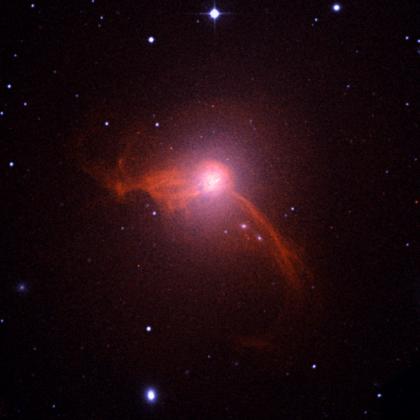shaileshs wrote: ↑Tue Oct 01, 2024 4:33 am
Just wondering -
1) What makes this BH so active in spitting out the jet-stream so long (distance), for so long (billions of years) ? Was there so much gas surrounding the BH that was "falling in" (quantity or type way different than other massive BH that are not spitting out such long and strong jet streams) ?
2) Why the "hotspots" at the end are not equi-distant from the "core" ?
3) What made one little "inner hospot" ?
4) If the BH has spit them out billions of years ago, wouldn't the light be super red shifted (and if so, how it was detected by "optical" observatories and not IR observatories) ?
5) Is this BH so isolated that there doesn't seem to be no other galaxy nearby within 23 million light years ?
6) How massive is this BH and how was it formed ?
Thanks in advance to all who provide answers and thoughts.
I don't have many answers to offer you, but I can give you some thoughts. I have no idea what made this black hole so active!

\_(ツ)_/¯
However, I don't think that this black hole has been
so active for billions of years. It is just that these black hole jets
existed billions of years ago, not that they have been active for billions of years.





Wikipedia wrote:
The W. M. Keck Observatory on Hawaii was used to show that Porphyrion is 7.5 billion light-years from Earth, and dates to a time when the universe was 6.3 billion years old.
Why are the "hotspots" at the jet ends not equi-distant from the "core" ? You mean, why are the two jets different? I don't think that is strange at all, because is all probability, the intergalactic medium that the two jets met was not the same. After all, consider how different the two jets of nearby giant elliptical galaxy M87 are!
In other words, we can't expect the jets from a black hole to be symmetrical.
So, what made the "inner hotspot"? I have no idea, but after all, the well-known jet from M87 - the one that we can easily observe - has little "hotspots" in it:
You asked how we could detect these black hole jets in optical light, even though their light should be super-redshifted. Well, as a matter of fact, the jets were detected in radio waves, which are much, much longer than optical light!
Is this black hole so isolated that there doesn't seem to be any other galaxies nearby within 23 million light years? No, not at all! Consider this illustration of Porphyrion and its surroundings:
All the little orange dots in the illustration above are galaxies!
And finally, how massive is this black hole and how was it formed? I have no idea! But the galaxy where the black hole resides is - or
was - ten times more massive than the Milky Way:
Wikipedia wrote:
To find the galaxy from which Porphyrion originated, the Giant Metrewave Radio Telescope in India was used along with ancillary data from the Dark Energy Spectroscopic Instrument in Arizona. The observations pinpointed to the galaxy J152932.16+601534.4, which is about 10 times more massive than the Milky Way.
Bear in mind that we are seeing these jets as they were 7.5 billion years ago. We don't know what the jets are like 7.5 billion years later, if they even still exist, and we don't know what the host galaxy is "today" - although the word "today" is hardly applicable to a galaxy that existed 7.5 billion years ago in a spacetime universe. Bear in mind that space and time are connected in our universe. The galaxy with the enormous black hole jets whose radio light reached us from 7.5 billion years ago has been carried away from us due to the expansion of the Universe, and we have no way of knowing how it has evolved in the last 7.5 billion years. So how can it be meaningful to talk about what this galaxy and this black hole are like "today"? When the "today'" of this galaxy may be beyond the edge of our own light cone of the observable universe?
Ann
 Porphyrion: The Longest Known Black Hole Jets
Porphyrion: The Longest Known Black Hole Jets





